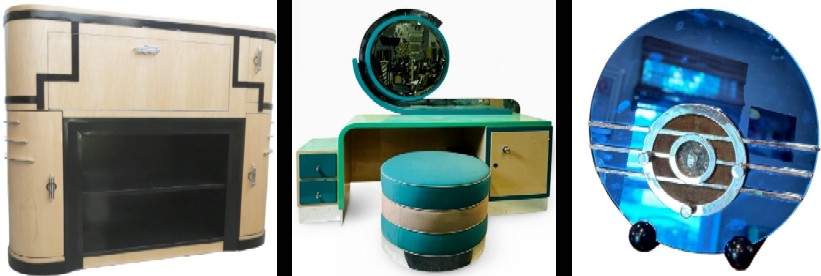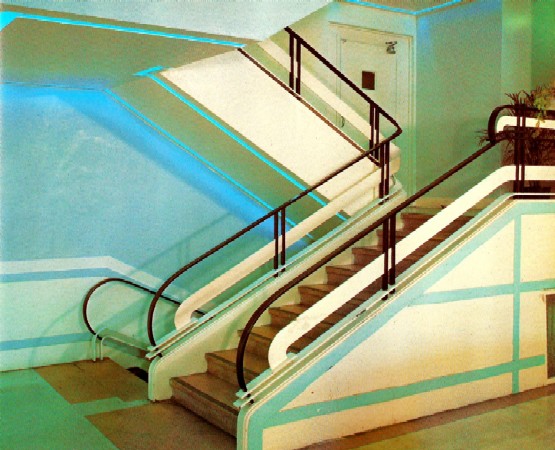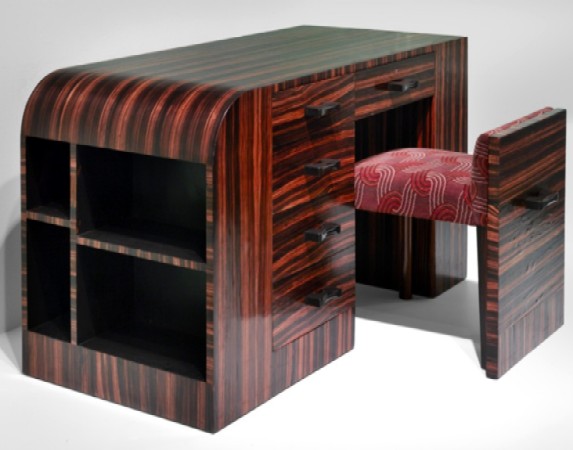
Streamline Moderne - An Art Deco Subcategory
Researching the different subcategories of what is often broadly called 'Art Deco', I found Streamline Moderne one of the most interesting. It is quite different from the style of the earlier Art Deco period, sometimes referred to as Jazz Moderne and Zigzag Moderne, among other things. I do not mean Streamline Moderne is stylistically different, rather the intent of the design is. This was discussed in some detail in a paper by William Kowalik from Temple University called

Streamline Moderne, Kitchen in Sarasota, Florida, 1936, Curves, No Drawer Pulls or
Handles, Polished Granite Floor, Backsplash, Counters, Black Banding, Pastels
and Browns, Glass Block, Sarasota Herald Tribune
"Streamline Moderne Design in Consumer Culture and Transportation Infrastructure: Design for the Twentieth Century". Kowalick looks at the differences between the earlier Art Deco period of the 1920s, which he simply refers to as 'Art Deco', and the Streamline Moderne period, primarily of the 1930s.
"The Art Deco style pioneered in the years following World War I, exhibited at the L'Exposition Internationale des Artes Décoratifs et Industriels Modernes of 1925 (translated to English as the International Exhibition of Modern and Industrial Decorative Arts). Art Deco, while certainly new, but was not entirely free of the ornamental motifs of the past. Additionally, Art Deco prioritized the handcrafted, high-end, and exclusive, providing exceptional design for those who could afford it. Streamlining was just that, stripping away the excesses of the past, of even a just few years prior.
...Streamline Moderne, also referred to as Art Moderne evolved from Art Deco as a more accessible style that was influenced by that present moment, the fast paced, contemporary life, taking cues from motion, speed, and transportation infrastructure—adopting an aerodynamic image. Key to Streamline Moderne over Art Deco was the widespread availability of items and products meant for everyday use by a far-reaching group of Americans." (Kowalik, not paginated).
From this, is can be seen that the Art Deco style of the 1920s targeted wealthy clients while Streamline Moderne was aimed at the general population. In reading about the way that interior design artists marketed their services. They worked with architects who were hired by wealthy clients to design custom homes, showing their styles at shows and expositions and, if they could get the eye of journists at these shows, appeared in magazines which showed the homes of wealthy clients. As a result of their target market, the designs and the materials used tended to be richer and more exclusive.
"Art Deco was a response to the devastation of the continent following what was described as the 'Great War'. Looking towards the future, designers for the upper-class created furnishings, decorative objects, and finishes in an angular yet organic style. This however was not entirely a departure from the past.
Streamline Moderne, Staircase, The Kenmore, Miami Beach, 1936, Tumblr Art Deco's organic design elements recalled the Art Nouveau style of the previous two decades, with a more modern and urban influence. Seeing this as the en vogue style, it was quickly adopted by affluent Americans and American designers, who had little to show themselves at the 1925 exposition." (Kowalik)
Significantly, Art Deco never fully divorced itself from previous styles in the way that Streamline Moderne was to do. Although Kowalik doesn't mention it, Streamline Moderne relied on the principles of Modernism (as the name implies), which removed decoration, highlighting the beauty of a room or objects function. In fact, one of the oft repeated tenets of Modernism was that 'form follows function'.
It is important to remember that the Art Deco movement took place in the United States and parts of Europe before the stock market crash and the Great Depression and the Streamline Moderne movement began after the crash and during the Depression. Many of the designers suddenly found themselves without a sufficient client base. In fact, it was around this time that the field of industrial design began to take shape. Industrial designers focused on creating pleasing designs which could be mass produced and sold more cheaply than the 1920s Art Deco interior designers hand made products could be. Modernism, with its focus on simplification, streamlining and form, lent itself well to the field.
"The accessibility, and perhaps mundane nature of Streamline Moderne is what makes it interesting because the extraordinarily significant nature of what this style accomplished as far as advancing design forward, while remaining so ubiquitous and ordinary. Architecture, furniture, decorative objects, automobiles and vehicles, and household appliances and fixtures all designed in the Streamline Moderne style held a prominent place in 1930s and 1940s American households. For the first time, a larger body of
Streamline Moderne, Desk with Integral Chair, Australian Walnut Veneer, Waterfall Side, Maurice Adams,
c. 1935, The Wolfsonian the American population was exposed to and maybe able to afford 'good' design that was not only aesthetically considered, but also new tools for a new century through time-saving products and transformative inventions, but also novelties of and for consumer fascination." (Kowalik)
There are important stylistic differences between 1920s Art Deco and 1930s Streamline Moderne. David Gebhard provides a list of characteristics of the Streamline Moderne Styles found in the 1930s in his 1977 book A Guide to the Architecture of Minnesota. Those he lists include:
- Rounded Surfaces - These are found particularly on corners of objects including furniture, windows and even the rooms themselves.
- Horizontal Orientation - An emphasis on the horizontal appears in most Streamline Moderne designs.
- Asymmetrical Composition.
- Use of Glass Block in Walls and Windows - Although primarily a external feature, it is also appreciated from the inside as we have shown here several times.
- Round Windows - Porthole window are popular items in doors and windows. The sometimes also appear as interior features and mirrors.
- Use of Steel - Gebhard talks about railings, but this is also frequently found in furniture.
- Brightly Colored Vitriolite (Pigmented Structural Glass) - I would add the use of a variety of new materials popularized during this period such as Bakelite, Masonite, Monel, Nickel-Silver and similar materials.
In addition to Gebhard's characteristics, other examples found in Streamline Moderne include the use of neutral colors like brown and white and soft pastels, veneers on furniture to cover less expensive woods and the use of parallel 'speed lines' to give pieces a sense of movement. .
Looking at all these philosophical and physical differences between 1920s Art Deco and 1930s Streamline Moderne, it is sort of unfortunate that they are often unceremoniously lumped together. For a deeper understanding of the physical differences between the two styles, see the entry on Zigzag Moderne.
Original Facebook Group Posting
 Streamline Moderne Furniture, from left - Freestanding Bar, Blond Maple Veneer, Black Lacquer, Nickel Hardware, American, 1930s, Modernism; Streamline Moderne, Vanity With Round Stool. Aqua Green And Pale Yellow Lacquer. Chrome Ball Hardware And Accents, Porthole Mirror, Paul Poiret, 1930s, Incollect; Sparton Bluebird Radio Model 566, Blue Mirror with Silver Speed Lines, Sparks-Worthington Company, Walter Dorwin Teague, 1936, 1st Dibs
Streamline Moderne Furniture, from left - Freestanding Bar, Blond Maple Veneer, Black Lacquer, Nickel Hardware, American, 1930s, Modernism; Streamline Moderne, Vanity With Round Stool. Aqua Green And Pale Yellow Lacquer. Chrome Ball Hardware And Accents, Porthole Mirror, Paul Poiret, 1930s, Incollect; Sparton Bluebird Radio Model 566, Blue Mirror with Silver Speed Lines, Sparks-Worthington Company, Walter Dorwin Teague, 1936, 1st Dibs

